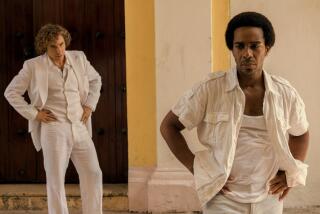Igniting Cigar Puffery
- Share via
Nick Reed is well-versed in cigars, an able judge of hue, texture and aroma. In the backyard of his home in an affluent New York suburb, he displays a mastery of technique: Cut off the tip, ignite the end, pause between puffs.
Effortlessly, Reed tilts back his head and emits a swirl of smoke shaped like a doughnut. He is 16.
Cigar makers, at about the time Reed was born, conceived a long-range plan to conquer new smokers--women, the young and the wealthy--and laid the foundation for a powerful myth that cigars are cool and sexy.
In a remarkable turnaround for an industry whose customers were dying off only a generation ago, the image of cigars today has even ensnared teenagers, a taboo audience that manufacturers say they have not courted.
Among the ways marketers resurrected the cigar: They hijacked the credibility of the media. News reports, they understood, were more likely to sway the public than paid advertisements.
“While the consumer of the ‘80s may harbor built-in skepticism when he reads an advertisement in a magazine or sees a commercial on TV,” said an internal memo of the Cigar Assn. of America Inc. in 1983, “he accepts and believes the public relations message because it reaches him in the form of news and information.”
For nearly two decades, cigar makers have manipulated the media into promoting their product, planting news stories and letters to the editor and zeroing in on sympathetic journalists.
Today, cigars are in such vogue that industry ploys may no longer be necessary. The same media that have relentlessly scrutinized the cigarette industry have embraced cigar smoking as a glamorous trend. A database survey of recent newspaper and magazine coverage shows that articles on cigars rarely focus on their hazards.
The industry also has used Hollywood to entrance the public. In a hidden form of advertising, manufacturers have paid Hollywood brokers to get stars to wield cigars on television and in the movies. Fearful of the impact on young viewers, Congress stamped out this practice nearly a decade ago when cigarette manufacturers were caught in the act. But the remedy did not cover cigars.
Until this week, when the Federal Trade Commission for the first time ordered five cigar makers to report advertising and marketing expenses, federal authorities have been so preoccupied with reining in the cigarette industry that cigars have slipped by unscathed.
Unlike cigarettes and smokeless tobacco, the cigar carries no U.S. surgeon general warning label. Nor are its ingredients disclosed to federal health authorities. Cigars have even escaped scrutiny as the government hammers out a comprehensive settlement to tighten regulations on cigarette manufacturers.
As a result, the cigar industry, a billion-dollar business catering to an estimated 12 million smokers in the United States, has obscured a simple truth: Cigars contain higher concentrations of tar and nicotine than cigarettes. And, health authorities say, cigars are just as deadly.
“It’s the most sophisticated campaign I’ve seen in a long time,” said tobacco expert John Pierce, professor of cancer research at the University of California, San Diego. “It’s so sophisticated that no one saw it coming.”
In a triumph of image making, the cigar, once a tired old prop of gangsters and grandfathers, has migrated from smoke-filled back rooms to the chambers of the well-to-do and the counters of the 7-Eleven. Everyone, it seems, is lighting up: conservative commentator Rush Limbaugh, pop singer Madonna, hockey great Wayne Gretzky, movie star Demi Moore, Hollywood heavy Arnold Schwarzenegger, supermodel Claudia Schiffer. Even President Clinton dabbles.
In the last five years, U.S. sales of cigars rose 26% to 4.49 billion, led by expensive premium cigars, which nearly tripled to 270 million. Cigar bars, cigar dinners and cigar clubs are popping up from coast to coast.
Cigar makers put forth a widely accepted explanation for their renaissance. They say that a spontaneous movement took hold with the spread of black-tie cigar events. That the launching of Cigar Aficionado magazine, the industry bible, offered a rallying cry. That there was a backlash against political correctness.
“It took everyone by surprise,” said Norman F. Sharp, president of the Cigar Assn.
Nearly two decades ago, cigar manufacturers did not concern themselves with young smokers. They had enough trouble figuring out why adults didn’t like cigars. Overall sales had been dropping an average of 5% a year since their height in 1964.
“We were very concerned about the inextricable, relentless decline in the cigar industry, and we felt we had to try something,” recalled Edgar M. Cullman Jr., chief executive of General Cigar Holdings Inc., a market leader in premium cigars.
With their survival at stake, industry chieftains formed a public relations committee in 1980 under the umbrella of the Cigar Assn. of America, a conglomeration of foreign and domestic manufacturers, leaf dealers and suppliers, and convened in New York for strategy sessions.
Among those in attendance was Cullman, regarded as one of the group’s sharpest minds, a Yale-educated executive and scion of the family who created another triumph of tobacco marketing, the Marlboro Man.
Joining Cullman around the table were other industry leaders: Stanford J. Newman of J.C. Newman Cigar Co., James Brown of Consolidated Cigar Corp., Thomas Arthur of Havatampa Inc. and John C. McCormick of Swisher International Group Inc.
The problem was all too familiar. As public relations specialist Robert T. Henkel told the assembled leaders of the industry in a private meeting in 1980, “The image of the cigar industry has to do with smoke-filled rooms--traditionally cited as the spawning areas where all sorts of nefarious schemes are hatched.”
Henkel’s solution, financed by Cigar Assn. dues and outlined in his speech, was a public relations message disguised as news and entertainment. Stories would focus on cigars as a status symbol, associating them with women and youthfulness and highlighting cigar-smoking celebrities as “role models for cigar smokers to emulate.”
“How will we do all this?” Henkel told the group. “We will write news stories, develop feature articles, take photographs, produce radio and television news tapes.”
Also, a grass-roots movement launched by the industry would create the illusion of public support for the cigar. The potential, Henkel said, could be as great as that achieved by advocates of women’s rights, the disabled and both sides of the abortion debate. “By the deft use of the media,” he said, those groups created a movement that shaped “the destiny for the many.” The cigar industry, he said, could do the same.
The importance of media attention was first identified in internal industry memos. “Objective: Keep cigars ‘in the news’ through placement of positive stories,” stated a Cigar Assn. memo early in the campaign. “Target Audience: News media.”
Success came quickly and in an impressive venue. A two-minute script produced by the Cigar Assn. was aired as part of a nationally televised news preview of the Super Bowl at the Pontiac Silverdome in 1982.
“And when it’s over, the victors will gather for the traditional ritual of slapping each other on the backs and pouring champagne--usually on each other’s heads,” a reporter said on camera. “And they’ll pass out the cigars that have come to be a symbol of manly success.”
The industry calculated its cost savings. A Cigar Assn. memo noted the next year: “A 30-second TV commercial during the Super Bowl would have cost $400,000. . . . However, we decided upon multiple exposures through TV news features which cost just $30,000. They reached 40 million viewers, resulting in a cost-effectiveness of 75 cents per thousand viewers--or less than one-quarter the cost of advertising.”
Cigar makers have attracted what other marketers fantasize about: wealthy customers clamoring for their wares.
“Create the ‘Cigar Smoking’ experience,” suggested a 1983 memo, “similar to the ‘Wine’ experience--the tradition of the grower, the roller of cigars, the boxing, the care of cigars, the smoking of cigars.”
Women, too, became a target audience, one the industry believed could “help get cigars again accepted as part of elegant entertaining,” according to a Cigar Assn. memo in the mid-1980s. Sharp, the industry spokesman, said manufacturers were only trying to make cigar smoking by men acceptable to women. But as early as 1978, when cigarette maker R.J. Reynolds Tobacco International was still in the cigar business, the industry giant began to see women as a potential market, concocting cigars with more palatable scents “to develop female acceptance,” an internal company plan stated. Other manufacturers soon followed.
Plans gradually turned to young, upwardly mobile professionals. “We’ll especially focus on . . . the increase in cigar sales among baby boomers or Yuppies,” the Cigar Assn. stated in a 1985 memo.
Promotions were so successful that cigar makers were telling themselves public sentiment was changing by the mid-’80s: “There is a growing perception, regardless of the reality, that cigars are back,” said a 1985 cigar association memo.
A year later, the Cigar Assn. was bestowed with a Silver Anvil Award from the Public Relations Society of America for “shaping a positive consumer image” through such traditional promotions as a song-writing contest.
While the industry denies that it targeted teens, usage among underage smokers is rising. The Federal Trade Commission said on Monday that new data released last summer show “significant usage patterns” among 14- to 19-year-olds. Besides ordering cigar makers to file advertising and marketing expenditures, the FTC told three of the five companies to report what they spend to have their cigars featured in movies.
Actors lighted cigars in 51 of 133 movies with a domestic box-office draw of at least $5 million in the most recent film survey by the American Lung Assn. Among them is “Independence Day,” the 1997 20th Century Fox hit in which cigars appeared in about 12 scenes, or once every 12.5 minutes.
Feature This, a Los Angeles product-placement firm, said it supplied J.C. Newman’s Cuesta-Rey cigars for use in the movie at the request of the filmmaker’s property master in charge of props. Fox at first said cigar product placement was not used in the film, and later declined comment.
Feature This has supplied cigars made by J.C. Newman and Caribbean Cigar Co. for several other films and television shows, according to company documents and interviews.
Other tobacco companies have gotten in on the act. General Cigar hired product-placement firm Keppler Entertainment Inc., which supplied two of the nation’s top-selling premium cigars, Macanudo and Partagas, for Sylvester Stallone and Whoopi Goldberg to use in “An Alan Smithee Film,” according to Hollywood production crew members and Keppler documents.
When asked about General Cigar’s ties to Hollywood, CEO Cullman said the company is ending its relationship with product-placement companies. “It raises the questions as you’re raising them now,” he said. Referring to the influence of movies on underage smokers, he said, “We as an industry are dead-set against” it.
Manufacturers maintain today that they did little to change the image of their product.
The industry campaign was “an abject failure,” said Sharp, president of the Cigar Assn. since 1981. He points to industry figures indicating a 37.5% decline from 1980 to 1988 in the consumption of large cigars--a combination of premiums and cheaper, machine-made cigars.
While overall cigar sales continued to decline, however, a key segment of the industry began to show signs of life. Sales of premium cigars doubled to about 100 million from the mid-’70s to the mid-’80s, just as the industry campaign was peaking. “I wouldn’t challenge the fact that they increased,” Sharp said. “But I would challenge the extent to which the PR program was a contributor to that.”
More to Read
Inside the business of entertainment
The Wide Shot brings you news, analysis and insights on everything from streaming wars to production — and what it all means for the future.
You may occasionally receive promotional content from the Los Angeles Times.










